THE AIRPORTS
PACIFIC NORTHWEST
SEATTLE-TACOMA INTERNATIONAL AIRPORT
SEA
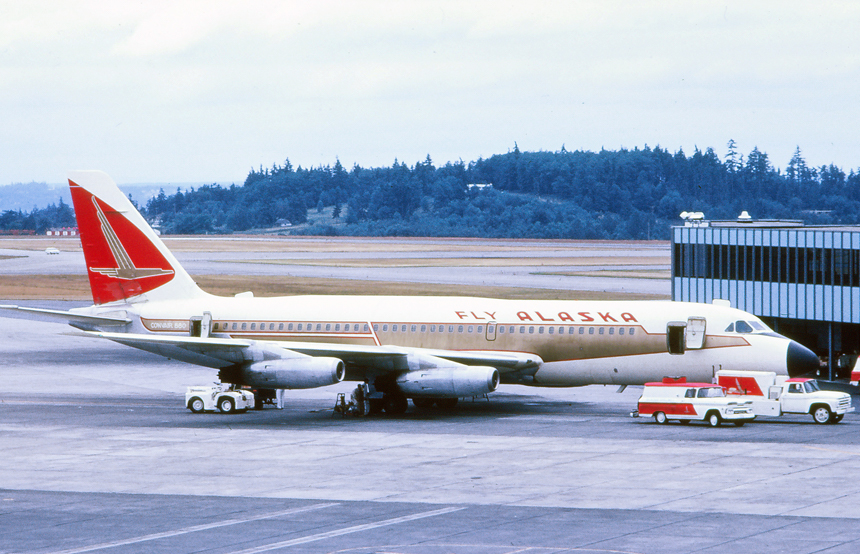
| April
1962 Alaska Airlines had remained a rugged, intra-Alaska carrier until 1951, when permission was granted to start service from Anchorage and Fairbanks to both Portland, Oregon and Seattle, Washington using the Douglas DC-6. As competing airlines, Northwest and Pan American introduced "jet" aircraft on the Seattle-Alaska service, Alaska soon fell short using piston-engined aircraft on the multi-stop eight hour routing. In 1961, Alaska Airlines ordered a single Convair 880 which would become the first jet type for the airline. The new Convair 880 "Golden Nugget Jet" would reduce flying time down to three-hours on the lucrative Anchorage-Seattle service. Parked at the terminal and being serviced for another flight is N8477H, a Convair 880M. |
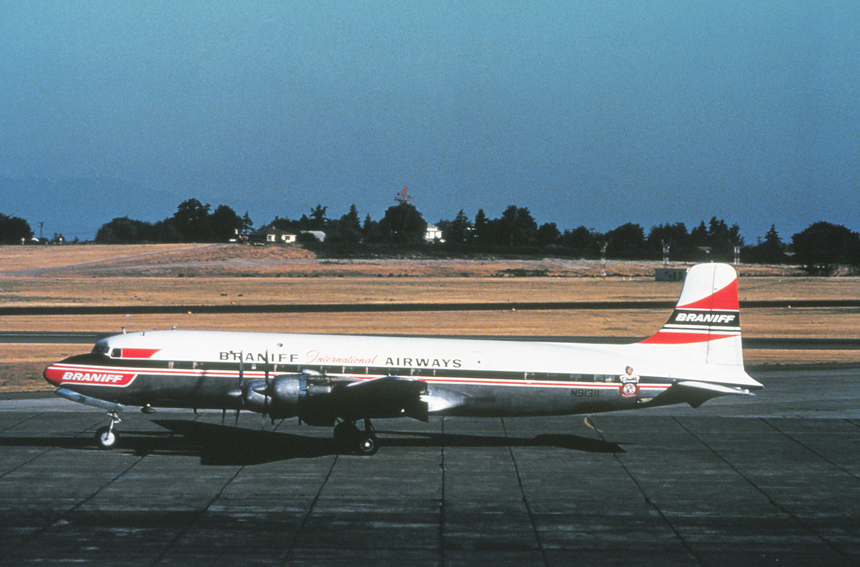
| June
1962 Braniff International Airways and United Air Lines started an interchange service between Texas and the Pacific Northwest in September 1953. A Douglas DC-6 was used on the flight from Houston to Seattle, via Dallas, Oklahoma City, Denver, Salt Lake City, Boise, and Portland. Braniff crews flew from Houston to Denver, with the United crew flying the same plane from Denver on to Seattle. Eventually Boeing 720 jet flights replaced the Douglas DC-6 in January 1965, however the interchange service arrangement continued. Taxiing inbound toward the terminal is N91311, a Douglas DC-6B. |

| October
1962 Seattle-Tacoma (Seatac) was built by the Port of Seattle in 1944, when the military took over operations of the existing Boeing Field. The new airport was built just south of Boeing field on a bluff in an upland plain. The first scheduled service from the airport was both Northwest Airlines and Trans-Canada Airlines which moved operations from Boeing Field immediately after opening. Over the next few years, United Airlines, Western Airlines, and Pan American Airlines relocated operations to Seattle-Tacoma. By 1957, the airport was hosting over four-hundred flights a week, with United Airlines being the largest carrier from the airport with over 260 flights weekly. The airport became a major intermediate point with flights heading to Alaska and hosted hundreds of cargo and passenger flights weekly. During 1962, Northwest Airlines served six cities from Seattle including flights to Portland, Honolulu, Anchorage, Spokane, and Chicago. During the same year 1962, Pan American was serving four locations including Fairbanks and Honolulu as well as its non-stop London services. Seatac, would eventually flourish into the largest commercial airport serving the Pacific Northwest. Parked on the apron and framed by the towering Mount Rainer is Pan American Airline’s N720PA “Clipper Fairwind,” a Boeing 707-321, and behind it a Northwest Boeing 707-320B. |

| May
1967 Alaska Airlines continued to be a large presence at Seattle-Tacoma International Airport and in 1966 the airline received its first Boeing 727 which also eventually replaced the Convair CV-880s. Alaska's new "Golden Nugget Jet" 727s were placed on daily flights from Seattle to both Anchorage and Sitka, Alaska as well as on intra-state Alaska flights. Parked at Concourse B a pair of Boeing 727s sit in the rain awaiting their next departures, including N798AS, a Boeing 727-90C, delivered new to the airlines in November 1966. |

|
September 1970 Western Airlines placed an order for the "stretch" version of the successful Boeing 727 in 1969, to supplement the existing fleet of Boeing 707 and 737 aircraft. The new series-200 planes would be placed on short to medium range trunk routes in the Western network and with a passenger capacity of 135-passengers would increase capacity in some markets. Seattle saw the Boeing 727 introduced in early 1970 initally on flights to both Los Angeles and Seattle. Taxiing in toward the gate at Concourse C on a clear fall morning is N2803W, a Boeing 727-247(Adv) delivered new to the airline in October 1969. |
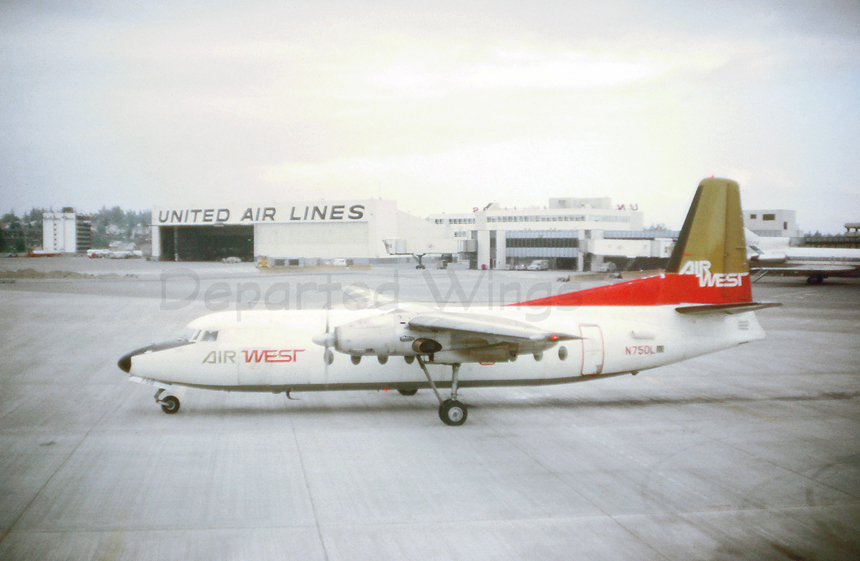
| May
1971 AirWest was the last airline to transfer passenger operations from Seattle-Boeing Field to Seattle-Tacoma International Airport in April 1971. AirWest had its roots at Boeing Field when predecessors West Coast Airlines established its base of operations from the airport in 1941. When the new Seattle-Tacoma International Airport opened just south of Boeing Field in 1944, most of the airlines serving Seattle's only commercial airport, Boeing Field moved to the new airport within a few years. West Coast Airlines then AirWest continued to utilize Boeing Field and was the last passenger airline to serve the airport. Seen departing the ramp at Concourse C for another regional flight is N750L, a Fairchild F-27A. |
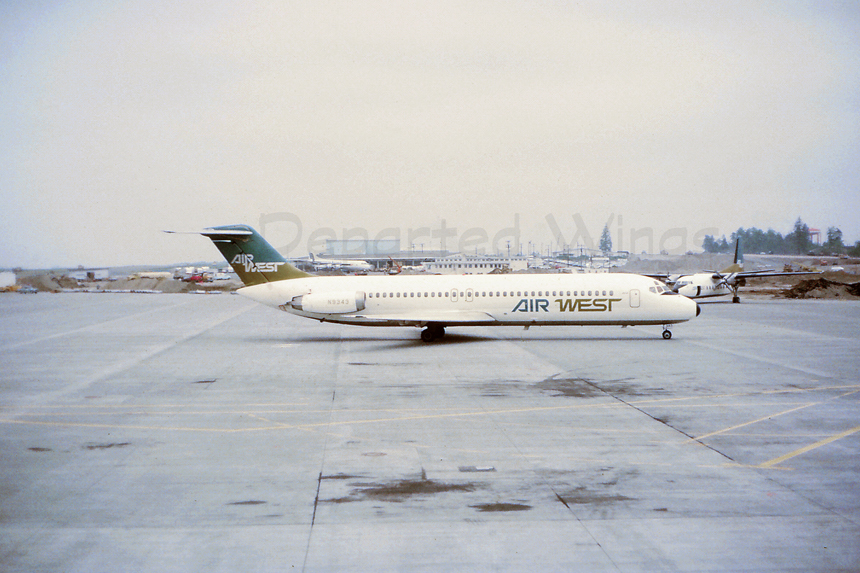
| May
1971 Along with the Fairchild F-27s, the Douglas DC-9s moved operations in April 1971 from Seattle-Boeing Field to Seattle-Tacoma International Airport. Although during this time, AirWest was officially considered Hughes Airwest, it would take some time for the planes to be repainted. With a transition to the new airport, Hughes Airwest was using the Douglas DC-9s on flights from Seattle to Pasco, Portland, and Spokane and providing passengers with more convenient connections to other airlines. Seen taxiing toward the gate at Concourse C after a regional flight is N9343, a Douglas DC-9-31. |
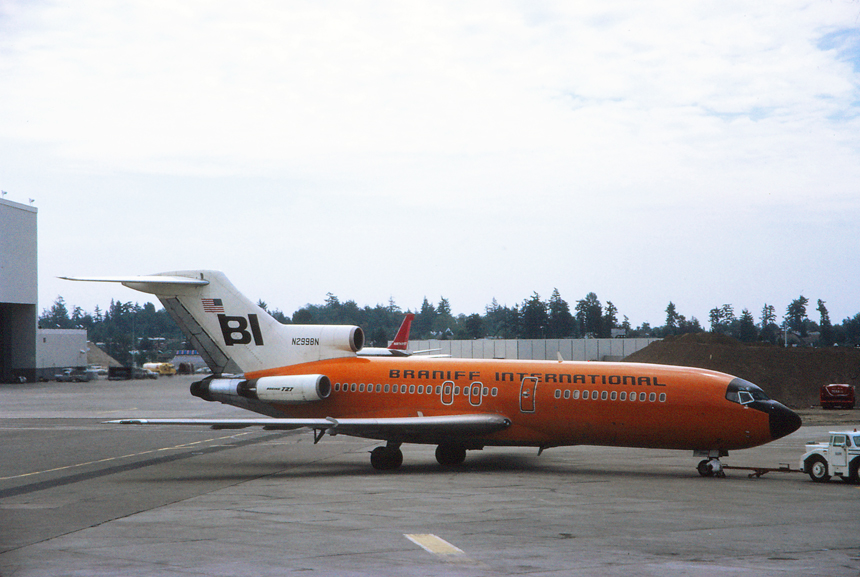
| June
1971 Braniff International Airways had operated to Seattle under an interchange agreement with United Air Lines since 1953 and was finally granted authority to provide its own service on June 13, 1967. Braniff would operate non-stop service from Seattle to both San Antonio and Dallas using Boeing 727s. Having just been pushed back from the terminal for an afternoon flight and wearing the "pastel" orange colors is N299BN, a Boeing 727-191, delivered new to the airline on April 17, 1969. |

|
September
1971 SAS Scandinavian Airlines was the first European airline to start international service to Seattle with non-stop flights to Bergen and Copenhagen in 1966. The Douglas DC-8 "Super-Fan" was used on the daily service which continued south to Los Angeles. Parked at the "new" Concourse A which is still under construction and being prepared for an afternoon departure is SE-DBK "Sigyn Viking," a Douglas DC-8-63. |
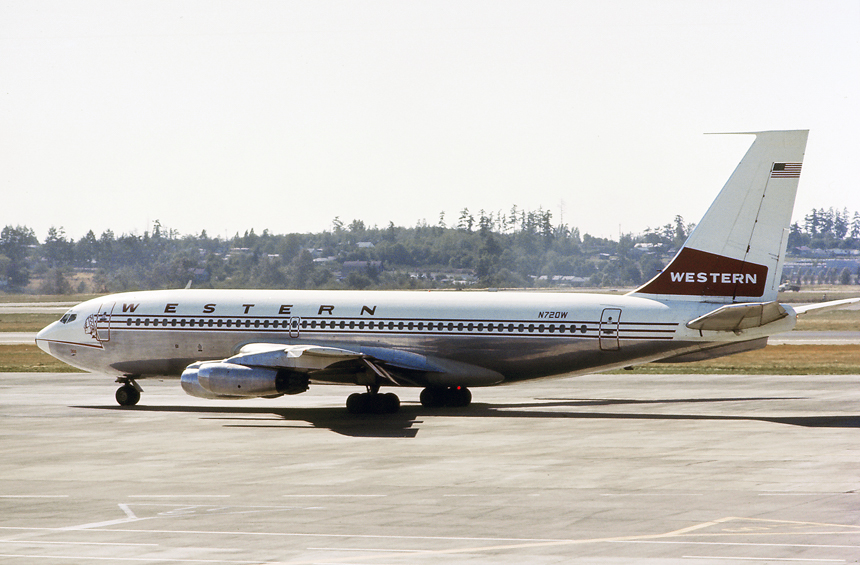
|
September
1971 Western Airlines was an early operator into Seattle when flights were started to Oakland via Portland and Tacoma in 1948. The airline increased it presence at the airport in 1967 when it purchased Pacific Northern Airways-PNA and the lucrative Seattle to Alaska routes as well as additional Boeing 720s. By 1973, Western was using the Boeing 720s on services from Seattle to Portland, Minneapolis-St. Paul, Los Angeles, and San Francisco. Seen taxiing away from the terminal for a mid-morning departure is N720W, a Boeing 720-062, originally with Pacific Northern Airways. |
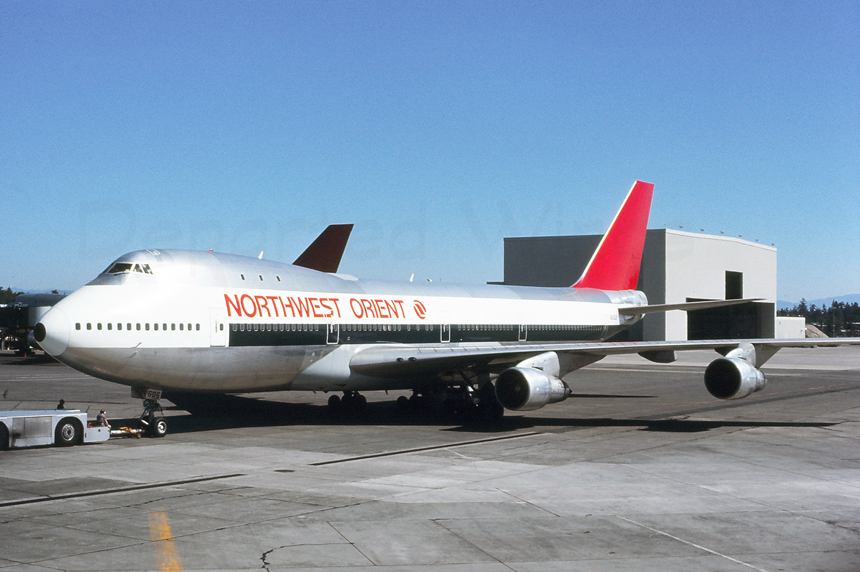
|
September 1971 Northwest Orient Airlines placed their new Boeing 747 in service on June 22, 1970. Within a few weeks, Seattle saw the Boeing 747s placed on the Chicago-Seattle-Tokyo-Henada on July 3, 1970. The "Regal Imperial" service on the trans-Pacific was well received by leisure and business passengers alike. Seen being pushed back from the South Satellite Terminal for a mid-day departure is N606US, a Boeing 747-151, delivered new to the airline a few weeks earlier on August 30, 1971. |
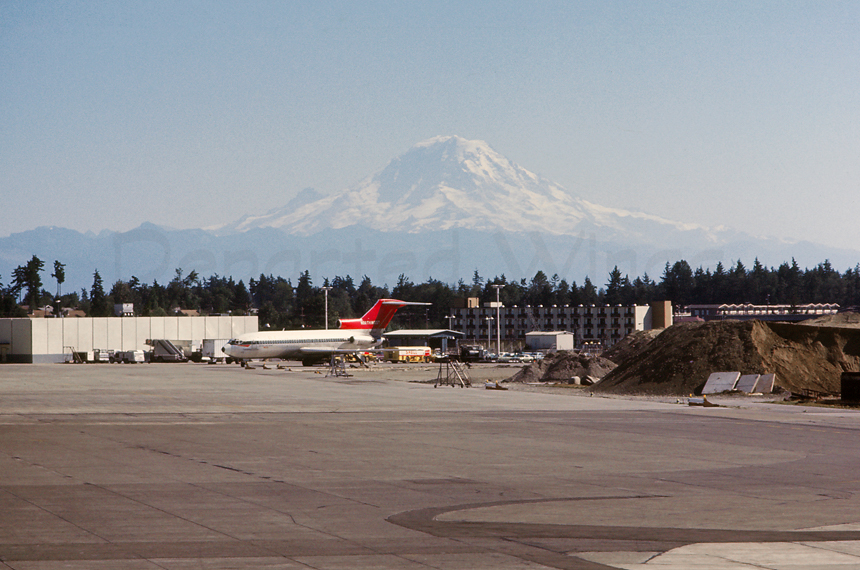
|
September 1971 The undistinguishable landmark of the majestic Mount Rainer frames the southeast vistas of the Seattle-Tacoma International Airport. At over 14,000 feet, Mount Rainer considered an active volcano as part of the Cascade Mountain range towers over the northern Washington landscape and can be seen on a clear day from both Canada and Oregon. Framed by the snow covered Mount Rainer is a Northwest Airlines Boeing 727-100 parked at the south ramp. |
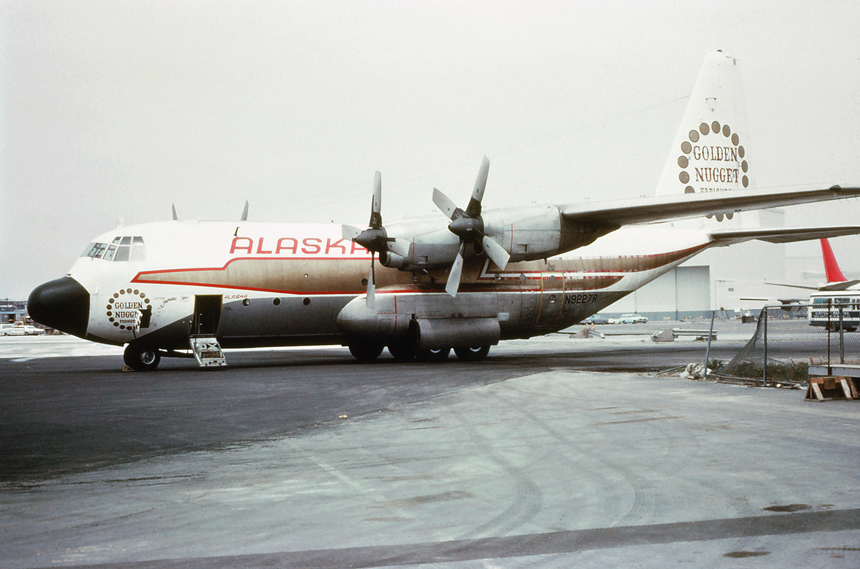
| October 1971 Due to the state of Alaska's remote and rugged wilderness, Alaska Airlines purchased six of Lockheed's civilian version of the popular military C-130 freighter, becoming the first airline to operate the aircraft. The four-engined turboprop was well suited for operating from austere airstrips, especially in support of North Slope oil activities around Prudhoe Bay, Alaska. Alaska's first "Herk" was acquired in 1965, and were operated through 1971 when they were sold to Alaska International Air. Parked on the cargo ramp is N9227R,a Lockheed L-100-30 Hercules. |
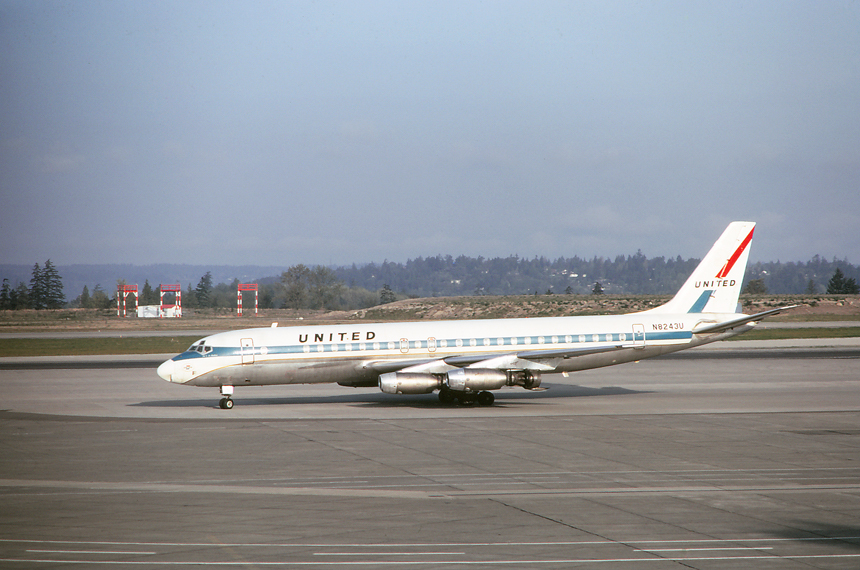
| April
1972 United Air Lines was one of the first airlines to provide passenger service to the Seattle area when flights were started by predecessor Boeing Air Transport (BAT) in 1919. Pacific Air Transport started mail service between Los Angeles and Seattle in 1926 with the two carriers merging in 1931 to become United Air Lines. Passenger flights were soon started from Seattle to Portland, Oregon via Tacoma. United then was the largest airline operating from Seattle with twenty-four weekday departures. When "jet" service was introduced in 1959, United used the new Douglas DC-8 to replace the Douglas DC-7 and Douglas DC-6 on flights from Seattle to Chicago and New York-Idlewild. Seen taxiing inbound toward its gate is N8243U, a Douglas DC-8-33, purchased by United in September 1968. |
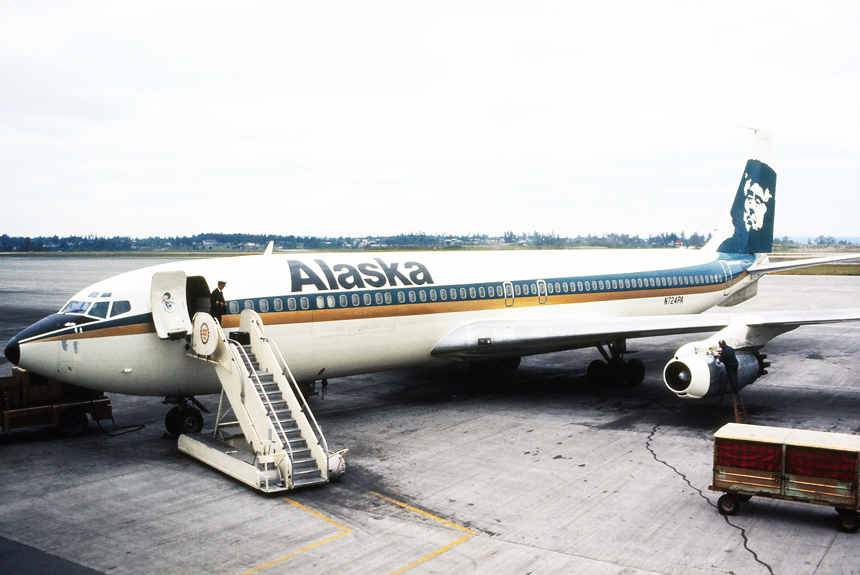
| May 1972 During the early 1970s Alaska Airlines leased a total of four Boeing 707s for added capacity during the peak summer season as well as charter flights to Siberia Russia. One of the 707s, an ex-Pan Am aircraft wearing British tour operator Donaldson Airways colors was used to increase cargo capacity on the Seattle-Ketchikan-Juneau-Anchorage route during the summer months. As the Russian charters dwindled due to the poor economy and additional Boeing 727s were added, the need for the 707s concluded. Parked on the ramp and being serviced for another flight to the "Final Frontier," is N724PA, a Boeing 707-321, originally delivered to Pan American Airways in December 1959, and leased by Alaska Airlines in March 1972 |
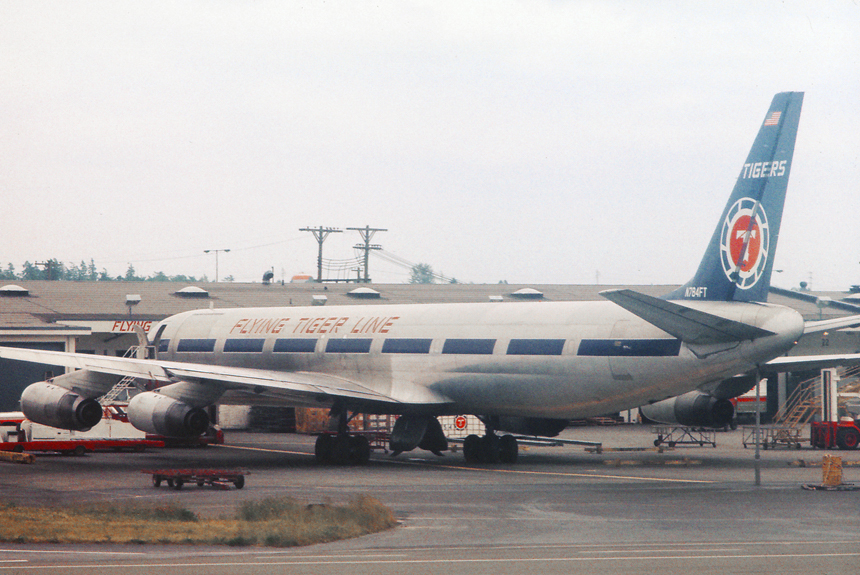
| May 1972 Flying Tiger Line was established after World War II in 1945 and became the first scheduled air cargo airline in the United States. The airline introduced "jet" freighter flights with the introduction of the Boeing 707 in 1965, but replaced those aircraft with the larger capacity Douglas DC-8 starting in 1968. Seattle was a mini-hub for the airline especially for flights across the Pacific into Japan. In the early 1980s cargo flights connected Seattle with Portland, San Francisco and Chicago, with trans-Pacific cargo service to Tokyo and Okinawa, Japan. Parked at the cargo ramp and awaiting another flight is N784FT, a Douglas DC-8-63AF, delivered new to the airline in October 1968. |
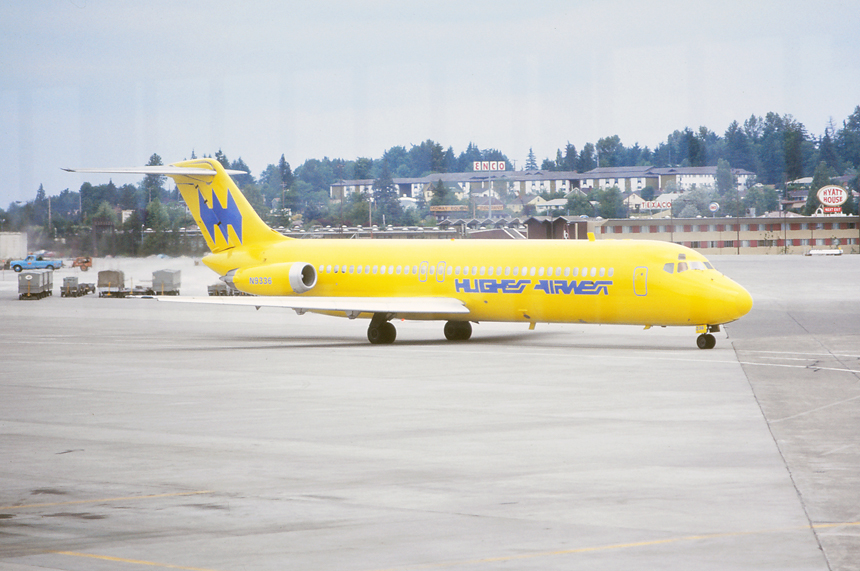
| May
1972 For a few years after the purchase of AirWest by Howard Hughes's Summa Corporation the AirWest fleet continued to fly in the "Fiesta" color scheme however in 1971, a new design was created and soon applied to the remaining aircraft. With the transition, Hughes Airwest continued to provide flights from Seattle to regional locations including Portland, Spokane, Yakima, and Pasco using the Douglas DC-9. Seen freshly painted and pulling in toward the gate at Concourse C is N9336, a Douglas DC-9-31, originally delivered to AirWest in November 1968. |
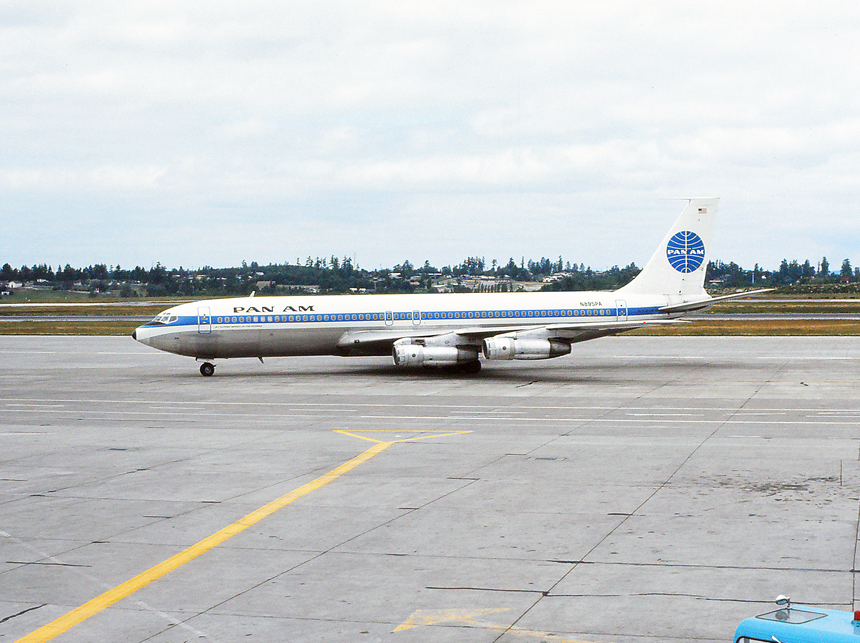
| May
1972 Pan American Airways entered the Seattle market in 1932, when the airline purchased Alaska Airways Inc. and started a Seattle-Fairbanks route. This became a lucrative link for the Pan American system for the next thirty years, eventually adding services to Juneau and Portland. Pan American started the first non-stop Europe service, when flights were started to London, England in 1961 using the Boeing 707 "Intercontinental Jet Clipper." By 1972 the airline had added trans-Pacific flights to Honolulu, along with its existing services to Fairbanks, London and Portland. Seeing taxiing inbound toward the gate after having landed is N895PA, "Clipper Herald of the Morning," a Boeing 707-321B. |

| June
1973 Northwest Airlines had a long history with the Seattle area, as its name suggests, when passengers services were started on a multi-stop Minneapolis-Seattle route in 1928. The airline took a foothold during World War II in providing critical service to Alaska and through to the Far East and Orient. Northwest was one of the first airlines to relocate from Boeing Field to the new Seattle-Tacoma Airport in 1947. The airline continued to grow becoming the second busiest carrier at the airport in 1957 with 80 weekly flights. The Boeing 707 introduced by Northwest in 1963 was placed on both intercontinental and trans-Pacific services. By 1973, Northwest Orient was still using the 707 to provide flights from Seattle to both Spokane and Minneapolis. Seen taxiing toward the terminal after having landed is N378US, a Boeing 707-351C, delivered new to the airline on March 29, 1968. |

| June
1973 The Seattle area has been host to numerous, smaller local service carriers connecting many of the island spots in the Puget Sound. Harbor Air was one such carrier was established in 1971, to provide flights from Oak Harbor (in the San Juan Islands) to Seattle. Using a fleet of Islanders, the airline expanded to serve Bellingham and Mount Vernon in Washington, and Astoria in Oregon. Parked on the commuter ramp and showing the size comparison between a neighboring Western Boeing 727 is N66HA, a Britten-Norman BN-2A Islander. |
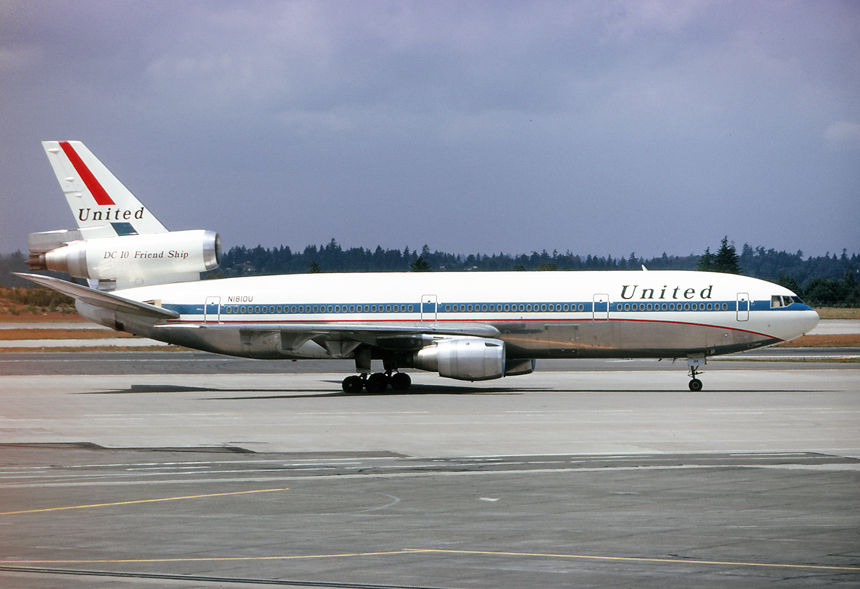
| June
1973 United Airlines was one of the launch customers of the Douglas DC-10 when thirty aircraft were ordered in 1968. The airline introduced the Douglas DC-10 on passenger service in August 1971 between San Francisco and Washington-Dulles. Seattle saw the Douglas DC-10 introduced on the trunk route to Chicago, but also the short, 165-mile route between Seattle and Portland, Oregon. Seen taxiing toward the terminal after having landed is N1810U, a Douglas DC-10-10 delivered new to the airline in April 1972. |
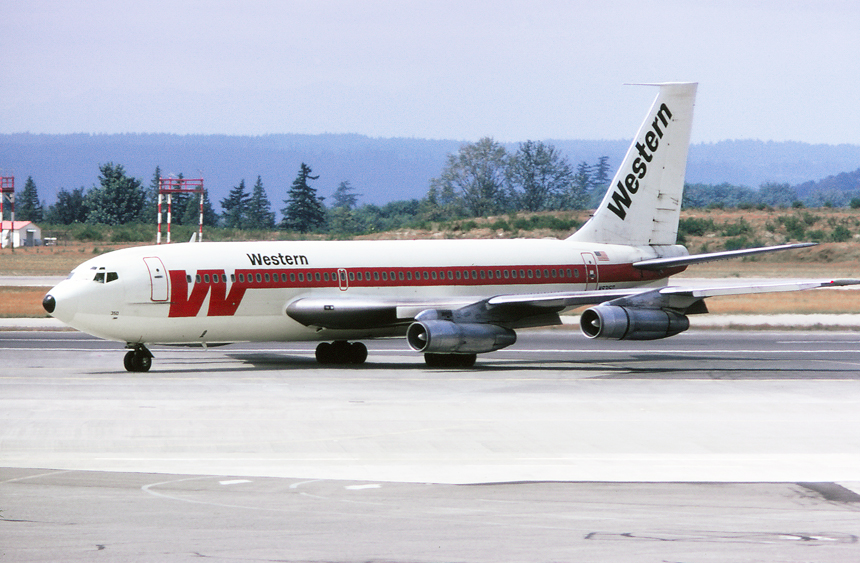
| June
1973 During late 1970, Western Airlines introduced a new corporate image replacing the "Chieftain" scheme being worn since 1959. Designed by agency Lippincott & Margulies of New York, a bold "W" trailed by a red stripe along the window-line became known as the "Flying W." Western faced litigation from the popular motorhome company, Winnebago Industries as they felt the new Western livery too closely resembled theirs. The new colors first appeared on a Boeing 720, and eventually as new aircraft were delivered, or existing aircraft underwent heavy maintenance, the identity transition was applied. Seen taxiing in toward the gate at Concourse B is N93150, a Boeing 720-047B, delivered new to the airline in April 1963. |

| May
1974 Northwest Airlines had established a rather strong foothold in the trans-Pacific market especially along in Far East Asia where the carrier was serving Japan, Korea, Taiwan, and the Philippines. So much had this connection grown that in 1961, the airline added "Orient" to its title and numerous cities in japan. During 1969, Northwest introduced a new corporate image with "Northwest Orient" titles, a navy blue fuselage stripe, and the retention of the red tail. Seen taxiing away from the terminal for a mid-day flight is N145US, a Douglas DC-10-40, delivered new to the airline in January 1973. |

| May 1974 Western Airlines placed its first of nine ordered Douglas DC-10s in service in May 1973, using the plane on domestic trunk routes and trans-Pacific service. With a capacity of 254-passengers, Western introduced the Douglas DC-10 on the important Seattle-Anchorage route in May 1974, and eventually placed the wide-body on flights from Seattle to Los Angeles. Seen pulling into the gate at Concourse B after a mid-morning flight from Anchorage is N904WA, a Douglas DC-10-10, delivered new to the airline in July 1973. |
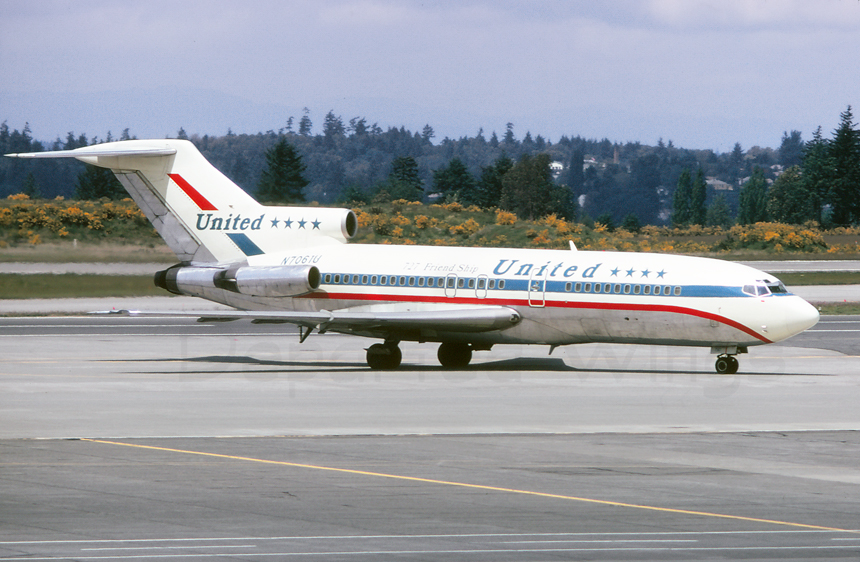
| May 1974 During the early 1970s, United Airlines was the largest operator from Seattle-Tacoma International Airport and had over thirty-five daily departures to eleven destinations, including international service to Vancouver, Canada. The Boeing 727 was the workhorse of the United fleet during the 1970s and the plane was seen on service from Seattle to Denver, Kansas City, Reno, San Diego, and Vancouver, Canada. Seen taxiing off the active runway and heading toward the terminal after having landed is N7061U, a Boeing 727-22, delivered new to the airline in April 1966. |
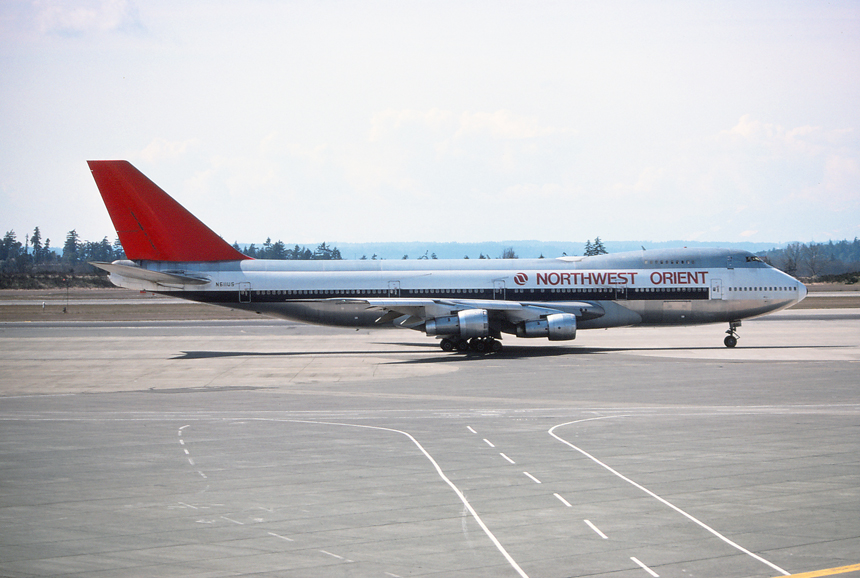
| April
1975 Northwest Orient Airlines placed an order for ten Boeing 747s in 1969, with the first being delivered in 1970. With a capacity of 369-passengers Northwest Orient introduced the Boeing 747 into service on June 22, 1970 between Minneapolis-St. Paul and New York-JFK. As more 747s were delivered they began to replace the Boeing 707 on trans-Pacific flights and saw service into Seattle with flights to Honolulu in December 1970. Seen taxiing away from the terminal for a mid-day departure is N611US, a Boeing 747-251B, delivered new to the airline in March 1971. |
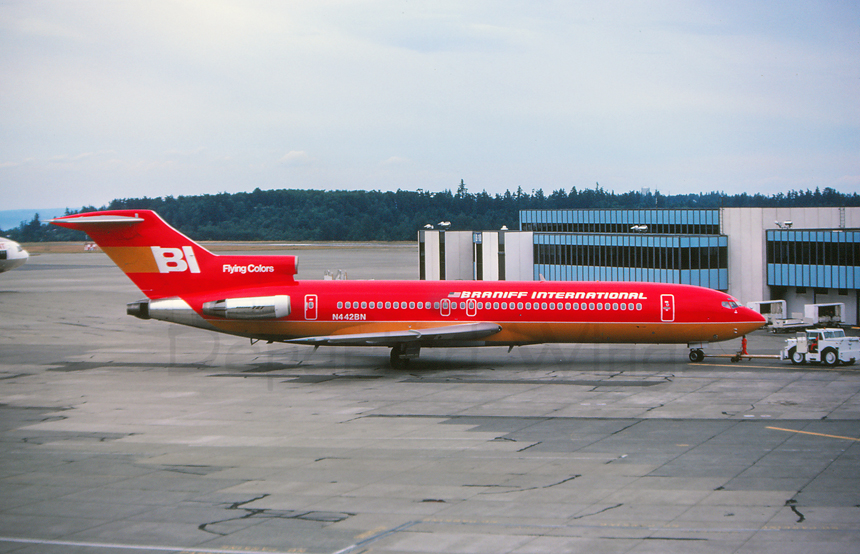
| January
1976 Braniff International Airways continued to serve Seattle but by 1975 had reduced services to a single daily flight to Dallas-Ft. Worth, and two daily flights to Portland using the Boeing 727. Seen wearing the red "Flying Colors" scheme and being pushed back from the gate at Concourse B for a mid-day departure is N442BN, a Boeing 727-227, delivered new to the airline in April 1975. |

| May 1976 Even with competition from major carriers, Northwest Orient and Western Airlines, on services to Anchorage, Alaska, Alaska Airlines established a solid reputation for services to the "Final Frontier." By 1976, the airline was flying four daily non-stop flights to Anchorage and was the only carrier serving the routes from Seattle to both Juneau and Ketchikan using Boeing 727s. Seen being pushed back from Concourse C for another northbound flight is N530EJ, a Boeing 727-155C. |
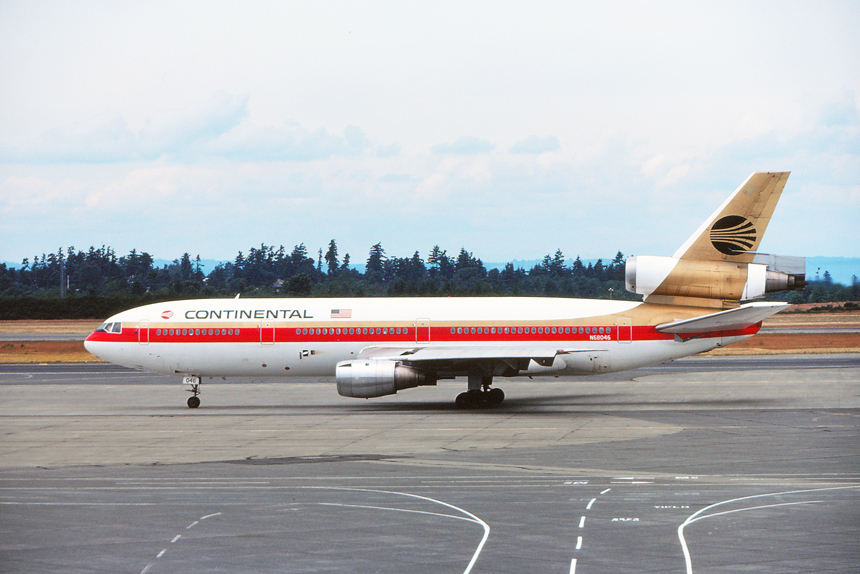
| July
1976 During the 1950s, United Air Lines and Continental Airlines inaugurated an interchange service between Tulsa-Denver-Portland-Seattle, with United flying the Douglas DC-6 from Denver onto Portland and Seattle. In 1969 Continental was awarded the Pacific Northwest case which allowed the airline to start service from Seattle and Portland to Southern California secondary cities. Soon thereafter, flights were started from Seattle to Denver, Dallas-Ft. Worth, Houston and Honolulu with introduction of the "heavy" Douglas DC-10 on flights to Denver and Honolulu during the early 1970s. Seen taxiing outbound toward Runway 34 Right is N68046, a Douglas DC-10-10. |
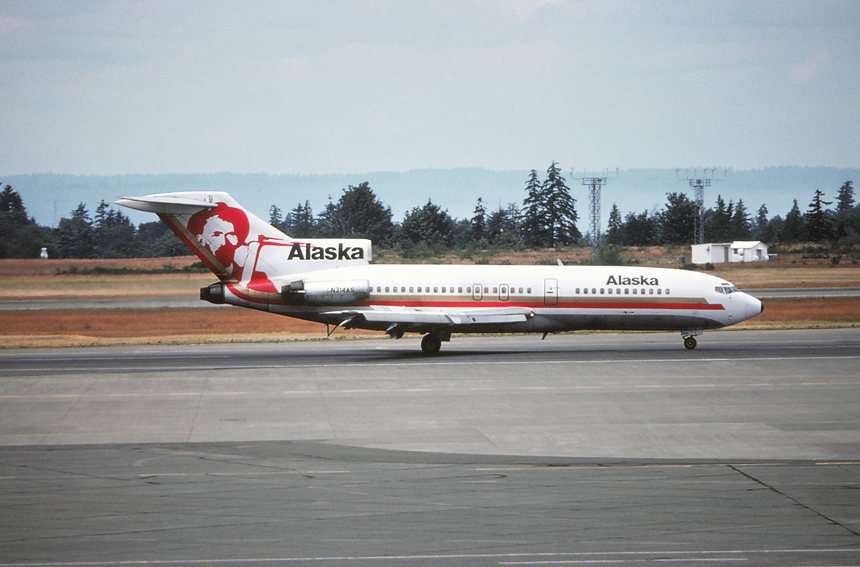
| July 1976 Alaska Airlines on the heels of a management change, introduced a new corporate image in 1973 to celebrate Alaska's heritage. Know as "Alaskana Graphics" four designs emerged that identified; "Gold Rush Alaska," "Native Alaska," "Russian Alaska," and "Inuit Alaska." All four designs had specific tail images and cheat-line colors and became a prominent advertisement for the airline. Seen taxiing outbound for departure is N314AS, a Boeing 727-21, displaying a hearty gold prospector on the tail which commemorated the Gold Rush days in Alaska. |

| August
1976 Even Alaska continued to be the prominent carrier to the "Final Frontier" state of Alaska flying the only services between Juneau and Ketchikan to the "Lower 48" with daily flights using the Boeing 727 and ensuring an continuous air connection to the rugged region. Caught taxiing inbound toward the gate at Concourse D is N316AS, a Boeing 727-21, wearing the "Inuit Alaska" graphics. |
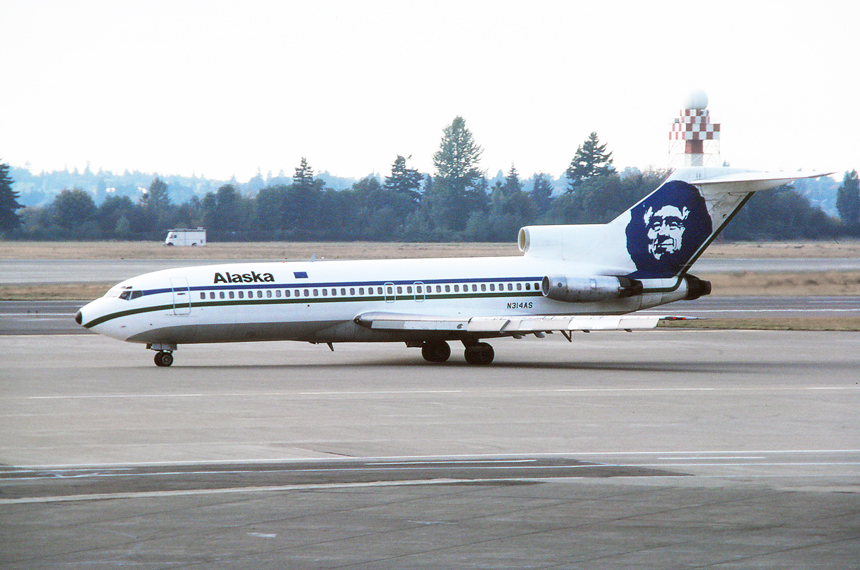
| October
1977 During late 1976, Alaska Airlines decided to standardize its corporate image and decided on the "Inuit Alaska" graphics with its well recognized Eskimo face and updated the cheat-line colors to blue and green, characteristic of Alaska's green forest and blue oceans. The Eskimo graphic was retired however with a slight adjustment from the original representation, the new one adding more of a smile. The airline eventually adopted the new slogan as well "Fly with a Happy Face." Seen taxiing toward its gate assignment after having landed is N314AS, a Boeing 727-21. |
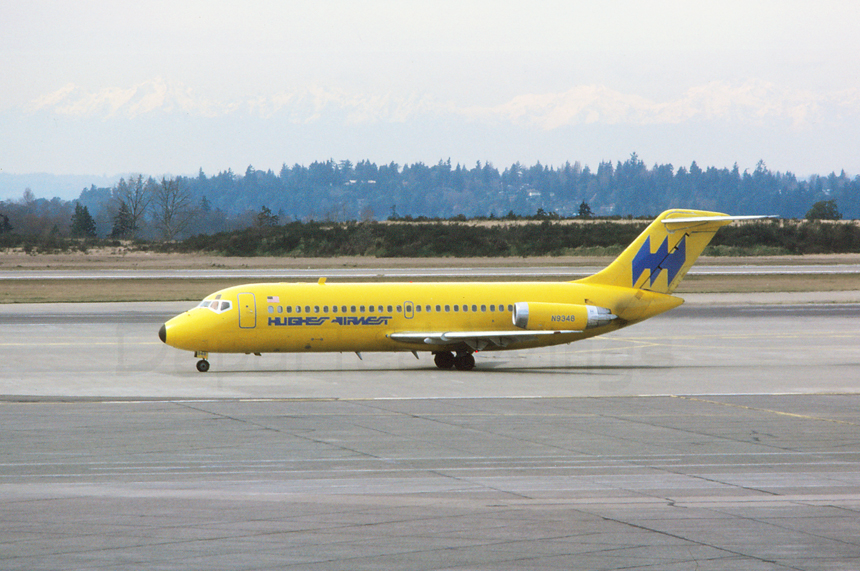
| March
1978 By 1976, Hughes Airwest had consolidated all operations from Seattle to use pure jet aircraft. The Douglas DC-9 series was providing multiple daily flights from Seattle to Pasco, Portland, Reno, Salt Lake City, Spokane, and Yakima. Seen taxiing out to the active runways for an afternoon departure is N9348, a Douglas DC-9-15, delivered new to Hughes Airwest in December 1972. |
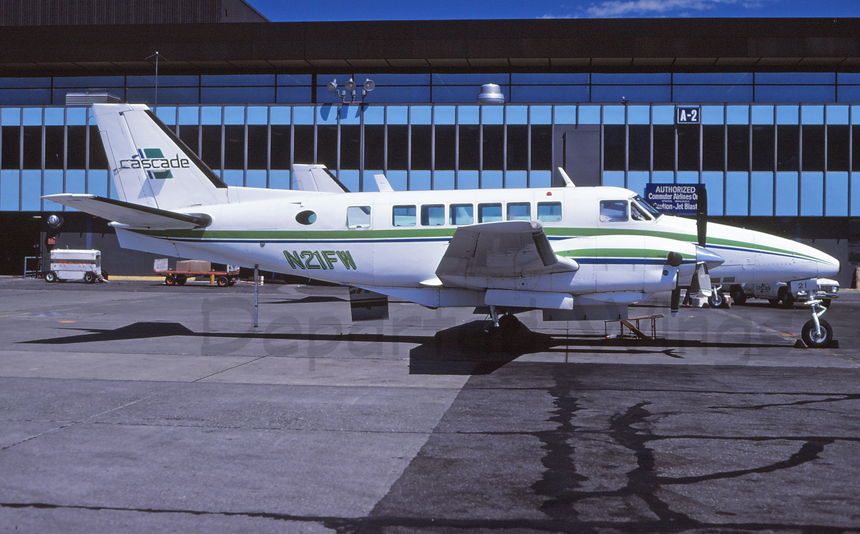
| June 1978 Spokane, Washington based Cascade Airways started operations in 1969 serving smaller destinations across Washington into Seattle-Boeing Field. During 1974, the airline moved its hub of operations to Seattle-Tacoma and got a boost in passengers through various code share agreements with the major airlines. Cascade was operating "commuter" service to six Washington locations including; Yakima, Walla Walla, Wenatchee, and Spokane using a fleet of Beech 99s. By 1978, the airline had grown to serve thirteen cities across three states and had become the largest commuter carrier of the Pacific Northwest. Parked at Concourse A and awaiting a load of passengers for an afternoon departure is N21FW, a Beechcraft B-99A, delivered to Cascade Airways in June1973. |
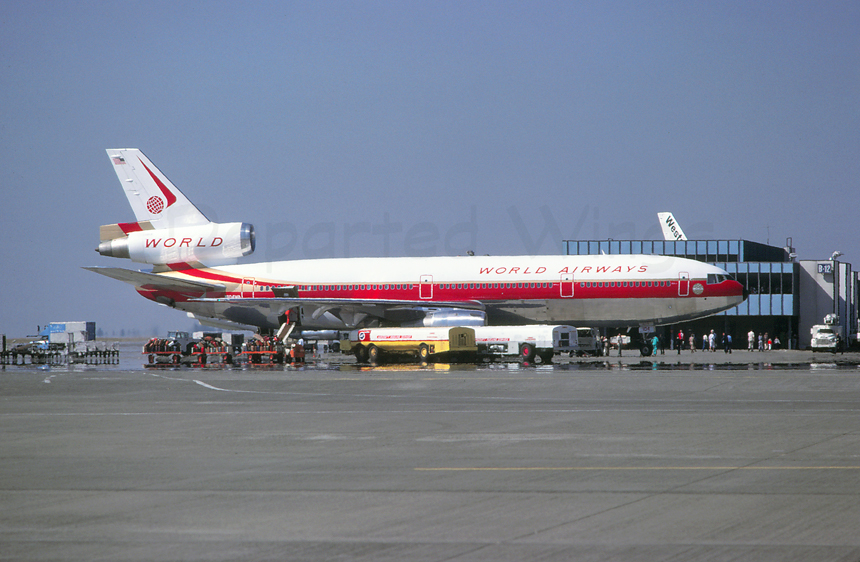
| August
1978 World Airways stared operations in 1950 as a supplemental airline and received its first government contract a year later in 1951 using Douglas DC-4s. Government military troop and cargo charters became World Airways prime business and when Boeing 707 and Boeing 727 jet aircraft arrived in the 1960s, the airline continued to expand. During the Vietnam War, World Airways was a key transporter of both troops and cargo from the mainland U.S. to Vietnam. In an effort to increase range and capacity World purchased three convertible freighter Douglas DC-10s for charter services. Seen parked at Concourse B and being serviced during a charter flight is N104WA, a Douglas DC-10-30CF, delivered new to the airline a few months earlier on June 15, 1978. |

| November
1978 When Continental Airlines started service into Seattle in 1969, the Boeing 727 was used to supplement the Douglas DC-10 on the trunk route to Denver and also provided non-stop service from Seattle to both Dallas-F. Worth and Portland. During 1978, service to San Jose, California was also started being the first airline to link the two cities. Seen rolling out on Runway 16R during an early evening arrival is N32722, a Boeing 727-224, delivered new to the airline on March 3, 1972. |

| July
1979 In response to the airline's 50th anniversary and a vision of entering the decade of the 1980s, Braniff International Airways unveiled a new look in July 1978. Known as a the "Ultra Look", a new brand image emerged and was designed to represent the epitome of elegance and sophistication. Aircraft interiors and exteriors were redesigned and a darker paint scheme complete with "pin striping" was applied in eight color variations. Wearing the "Perseus Green" colors and rolling out on Runway 16 Right during an afternoon arrival is N461BN, a Boeing 727-227, delivered new to the airline in September 1978. |

| August
1979 Pan Am had pioneered Seattle's first non-stop connection to Europe in 1961 when flights were started to London, England using a Boeing 707. When Pan Am introduced the Boeing 747 in January 1970, the plane was initially used on flagship routes such as New York-JFK to London. As more "Jumbos" arrived they replaced the Boeing 707 on key routes and in 1977 was placed on the daily Seattle-London non-stop services. Seen touching down on Runway 34 Left after a trans-Atlantic flight is N902PA "Clipper Mandarin," a Boeing 747-132, delivered new to the airline in May 1978. |
Back to: The Airports